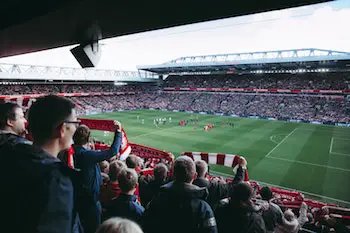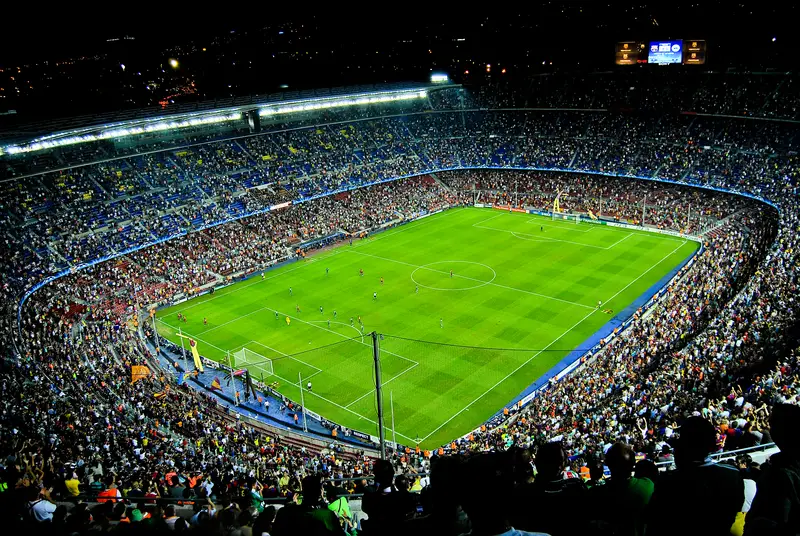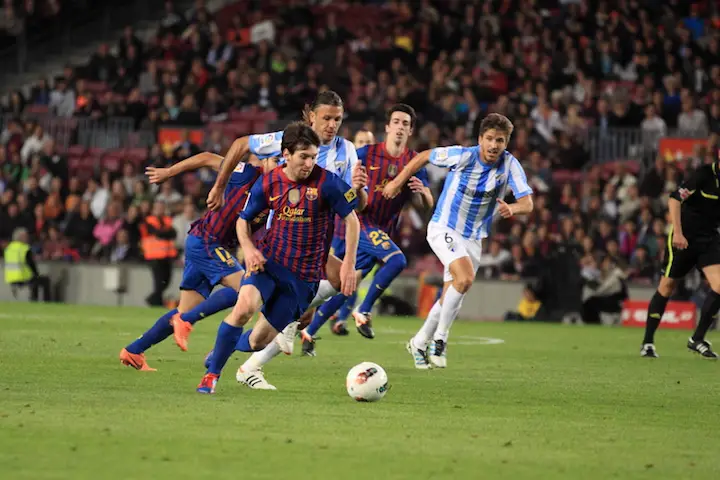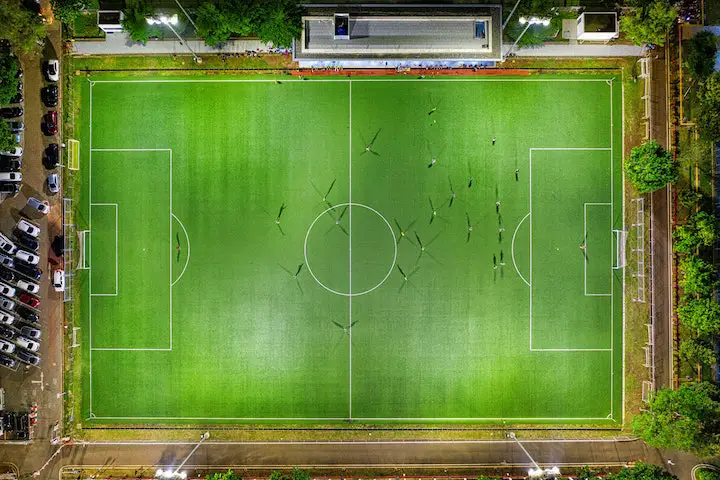Football has existed for thousands of years and has evolved since EARLY forms of the game were played in ancient Greece, Rome and China.
MATCHES used to be played by large groups of local people who would gather to kick the ball in a marked area, field or road. In some civilizations, a rock was even used instead of a ball.
Your Guide
 Alex Waite
Alex Waite
Fans of the sport have existed for as long as SOCCER has been played, regardless of whether it has been played with a ball or a rock.
Before the modern additions to the game of cameras, advertising, stadiums and screens, people would attend local matches of soccer and watch.[1]
Fans are not just passive spectators of the sport. Instead, they are ACTIVE PARTICIPANTS in the spectacle.

The fan’s involvement is not just to watch the action, as supporting a football team presents an opportunity for people to express their IDENTITY. Football fans ‘are not merely the crowd; they are the chorus’.[2]
Although the football fan has existed as long as the game has been played, actually supporting and committing allegiance to one particular club is a relatively modern aspect of football following the rise of professional football clubs in the United Kingdom and Europe during the mid to late 1800s.
In the 19th century, football organizations began to control the game with more widely applied RULES.
The first organization to implement this was the English Football Association, formed in 1863. The FA wanted to bring in a set of general rules for a group of teams who had previously followed their own regional styles of the game. [3]
Similar football associations WERE SET UP in the rest of the United Kingdom and Europe towards the end of the 19th century and at the beginning of the 20th century.
Centralized rules introduced by these associations brought football into the professional era, and more clubs began to form in towns and cities across the UK and Europe.
Clubs were regularly formed by religious leaders from local churches or by philanthropists looking to prevent young men in urban areas from gambling or joining trade unions in their FREE TIME. [5]
For this purpose, teams such as Rangers, Everton, Arsenal and Manchester United were all formed by local religious groups or groups of workers from the factories and mills.
The rise of local clubs gave footballers a chance to play for their nearest geographical team, but locals could also gather to cheer on and support the players.
HISTORICAL footage shows how spectatorship of football in the UK had grown to tens of thousands of people by the end of the 19th century as people were beginning to attend games on a large scale.[6]
The football boom taking place in this period coincided with SOCIAL changes to the working week in the 1880s, allowing people to pursue their favored leisure activities. With this, football ‘fanaticism’ was growing.[7]
Football clubs and fans have developed a co-existence with each other based on social and cultural identity.
Whether it is local, national or GLOBAL, football has become more than a match between two teams of eleven players, it has become a sport that embodies the social fabric of individual fans, which is played out through the teams on the pitch.[8]
The ‘Old Firm’ derby in Glasgow, Scotland, between Rangers and Celtic, is a perfect example of how communal and individual cultural and religious structures are reflected through football.
The history of Catholic and Protestant tensions that have existed in the city for centuries RE-SURFACE for this fixture creating a small-scale representation of the two religious groups in the city.
In Glasgow, Rangers fans largely associate themselves with Protestantism. Fans will chant “Rule Britannia”, display Union Jacks, and hold up orange jerseys, a homage to ‘William of Orange’ or ‘King Billy’ who dethroned the Catholic monarchy in 1688.[9]
Conversely, Celtic fans are synonymous with Catholicism and represent their identity by unveiling Irish flags and SPORTING the Irish tricolor during their fixtures with Rangers and some sections of Celtic supporters have been reported singing Irish folk and rebel songs at matches in the past.[10]
These actions are both a symbol of the fans’ cultural and religious associations and a taunt to the opposition, steeped in years of CONFLICT that have taken place for centuries in the city.
El Clasico, an internationally renowned fixture between Real Madrid and Barcelona in Spain, also has a deeper cultural meaning for the FANS and their clubs which goes beyond football.
The fixture is symbolic of the contrast between the country’s social hierarchy in two different regions.
Madrid’s links to royalty, wealth and control have helped the club to establish an illustrious history and domination of the Spanish league and European competitions for decades.
Real Madrid currently has eleven European Championships and 33 Spanish league titles in their TROPHY cabinet.
In comparison, their Catalan rivals from Barcelona have always embodied independence, progressive thinking and opposition to the ruling regimes, which are historically linked to Madrid.
The Catalunya region famously opposed the rule of Spanish dictator General Franco, who supposedly had links with Real Madrid and tried to ban the Catalan language and oppress the region between the 1940s and 70s.
Barcelona is the capital of Catalunya and the fans perceive the city as their capital, which causes tensions between the two cities and fans when they meet.
In the build-up to and during El Clasico, the fans play out the identities of their region.
They want to represent their local heritage and the cultural-political hostility between the two regions are still relevant in modern-day Spain as much as they were in the 20th century.
These identities are so entrenched that Barcelona fans regard their club as the “national team,” while Real Madrid supporters believe that Barcelona is a club that represents “anti-Spanishness.”[11]

Camp Nou Barcelona Spain
The inclusion of football in the modern Olympics in 1900 and the formation of the FIFA World Cup in 1930 have presented the opportunity for entire nations of football FANS to support their team on an international scale.
International competitions have helped fans to harness national pride for their country. [12]
This global expansion of the sport means fans can both support the team in their local town or region, but it also gives fans another, larger scale where they can channel their SUPPORT towards a national team.
On the global stage, a fan’s identity is reflected by the team of players representing their country.
Clashes between nation-states on the football pitch can provide fuel for the fans to express the pollical, social and religious ideologies of their nation.
Famous rivalries between England and Germany, Argentina and Brazil, Spain and Portugal, Serbia v Croatia etc. exist because of historical TENSIONS between nations which ultimately form the supporter’s worldview of other nation-states.
In some ways, these rivalries can cause further fractions between nations and individual fans. Honduras and El Salvador met on the pitch three times in 1969 for the World Cup qualifying matches.
Severe violence occurred in all three fixtures between fans and it was clear that the clashes were a symptom of historical CONFLICT between the two countries rather than a result of the football matches.
Eventually, El Salvador won after the third meeting and they qualified for the World Cup finals, which took place in Mexico 1970.
But violence, social and political unrest and death occurred in the build-up to these fixtures. The conflicts were so awful that they were referred to by the press as the ‘Football War.
This term was used as a coincidence that the match occurred during this violent war between the countries over the ruling elite and their control over employment and citizenship across the two nations.
In this case, El Salvador’s VICTORY only heightened the violence and reaction of people from both countries and conflict occurred between citizens, police, armies and between the two presidents of each country. [13]
Football fixtures like this are so important for the fans and signal an opportunity for social and CULTURAL EXPRESSION like any other.
Therefore, the success of a football club or nation in the footballing arena is more than just a win or a loss, it is symbolic of pride and HUMILITY for what a person stands for.
In the most extreme cases, supporting a country can be life or death, as the Honduras v El Salvador fixture demonstrates.
Football clubs can also embody familial ceremonies and heritage spanning across generations.
This support becomes ingrained in the history and culture of a region or town. In many instances, parents and grandparents regularly instill their support of a club into their children, which creates whole families of supporters of the same team.
The supporters of the Scottish football team Dundee represent the fluent links fans often make between their families and the club they support.
Dundee’s stadium, Tannadice, is a community setting where family values and history can be DEVELOPED.
Furthermore, linking traditions of the club’s history to family history has been an important part of the social fabric and culture of Dundee and this tradition of supporting the club embeds a sense of belonging within a community.[14]
A football club does not just provide entertainment for the fans to gather to watch, the sport can be a communal and social lifeline for people who follow a club.
Often, the club an individual supports from CHILDHOOD is not as random as picking a name out of a hat…
…it is a reflection of this person’s history and character and in a familial sense, “Supporting Millwall, Real Madrid, Barcelona or Manchester United isn’t usually a decision that’s open for discussion in some families.”[15]
Professional players occasionally interact with the fans they entertain on matchday; this is an important ritual in the relationships between fans and their TEAM.
Recent images have surfaced of England players in pubs watching matches with fans or standing with fans spectating the game from the terraces.
This engagement is VITALLY important and strengthens the bond to create togetherness between players and their local community.
Alex Oxlade-Chamberlin, a midfield player for Liverpool, watched an England World Cup fixture in East London last year.
And explained his perspective of the fans after this experience of mingling with fans cheering on the country, “it was really special and a reminder of what it means to play for England and how special that is.”[17]
However, this human interaction tends to occur less regularly due to the nature of professionalism in the modern game and possibly due to the nature of the media and its impact on players, managers, and directors.
It seems that the media and the internet play more of a PROMINENT ROLE in evolving the way interactions occur between fans, players and clubs, as the abundance of output in newspapers, websites, blogs and social media can reveal how footballers live their lives.[18]
The act of charity from the club’s in the community and building a bond with the city they represent.
It is believed that football clubs can interact with fans and people in communities in unique ways that extend beyond matchday and positively shape people’s identities.[19]
Charitable acts have been closely linked to football in history.
Football matches used to present opportunities for charities to collect money from supporters, while CHARITY fixtures could be organized to fundraise money for local beneficiaries.[20]
Historically, football clubs have supported charitable causes and disasters in local areas, demonstrating how important a local team can be for supporting the local community and supporters.
Everton raised funds in 1910 following the sinking of a ship, the Ellan Vamin in Liverpool Bay, while The Lancashire FA arranged fixtures in 1883 following a major mining disaster in Altham.[21]
There is a shared EMOTIONAL element that comes with supporting a football club.
Since matches have been televised, there have been:
- Countless images on display of fans on their seats in celebration.
- Gritting their teeth and bellowing in anger from the pits of their stomach.
- Even with heads in hands and
- Tears stream down faces with disbelief at a decision or last-minute goal.
This is apparent for players, managers and owners, too and there have been instances where it seems everyone associated with a club has had a collective EMOTION.
Perhaps one of the most shocking events that unified a set of supporters and their club was following the disastrous events at Hillsborough on May 1989.
Ninety-six fans died on this day as the result of overcrowding in the away end at the football stadium. Fans were crushed as the game played out on the pitch in front of them, many tried to climb over the fences that contained the fans.
Unsurprisingly, the GRIEF that followed unified families, fans, the community, players, the manager and the city associated with the football club as they paid tribute to those who died on that day.
Even today, tributes are laid at Anfield, the team’s stadium, and Liverpool City Hall and even today’s younger fans, most of whom wouldn’t have been born, are also unified in the club’s mourning of those who tragically died at Hillsborough.
The modern-day nature of football means that clubs are becoming less reliant on fans, at least FINANCIALLY as most money comes from broadcasting revenue, especially in the English Premier League.[22]
But the relationship between fan and club needs to exist for reasons beyond this money and income.
The football fan’s devotion to their club is more than just about going to a match and watching the game.
As the former Scottish manager, Jock Stein, once said, “Football is nothing without fans”. The sense of community and TOGETHERNESS in football is hard to replicate amongst a large group of people.
This community is so important for a cultural, political, national and religious identity for fans to have an outlet to express themselves and their heritage.
Arguably, having a football team to follow is the most important aspect in many people’s lives and in certain instances, supporting a football team acts as a modern ‘surrogate’ to religion.[23]
References
[1]https://www.footballhistory.org/ (accessed 4th September 2019)
[2] Goldblatt, David, The Ball is Round: A Global History of Football (Penguin, UK 2007), p2
[3] Goldblatt, David, The Ball is Round: A Global History of Football (Penguin, UK 2007), p3
[4]https://www.thefa.com/about-football-association/what-we-do/history (accessed 6th September)
[5] Mitten Andrew, The Rough Guide to Cult Football (Rough Guides; 2 edition: 2010), p6
[6] Cheetham, Arthur, “Blackburn Rovers v West Bromwich Albion. Autumn 1898”, Vimeo, North West Film Archive, https://vimeo.com/108880463
[7] Brown, Paul, Savage Enthusiasm: A History of Football Fans (Goal Posts Publishing, UK, 2017), p10
[8] Goldblatt, David, The Ball is Round: A Global History of Football (Penguin, UK 2007), p4
[9] Foer, Franklin, How Soccer Explains the World: An Unlikely Theory of Globalisation (Harper Collins, New York, 2004), p36
[10]Brown, Adam, Fanatics: Power, Identity and Fandom in Football (London Routledge, 2002), p209
[11]https://www.theguardian.com/world/2011/may/01/madrid-barcelona-cultural-rivals (accessed 13.09.2019)
[12] Tomlison, Alan and Young, Christopher (eds), German Football: History, Culture and Society (London Routledge, 2006) p xi
[13]https://www.bbc.co.uk/news/world-latin-america-48673853 (accessed 9th September 2019)
[14] Andrews, Heather, “Football’and’Family:’The’Influence’of’Family’on’Team’Support’Among’Dundee’United’Fan”, Ethnographic Encounters, Volume 4, no1, (2013), p2-3
[15]https://www.academia.edu/35665584/Performing_identities_Understanding_how_stadiums_fans_and_players_interact_in_football_draft_ (accessed 13.09.2019)
[16]https://www.bbc.co.uk/bbcthree/article/17c2ca60-316e-46ba-b15b-4c3d562899ad (accessed 13.09.2019)
[17]https://www.theguardian.com/football/2019/sep/05/alex-oxlade-chamberlain-winner-euro-2020-england-pub-fans (accessed 13.09.2019)
[18]https://www.academia.edu/35665584/Performing_identities_Understanding_how_stadiums_fans_and_players_interact_in_football_draft_ (accessed 13.09.2019)
[19] Jenkins, Heledd and James, Laura, “It’s Not Just a Game: Community work in the UK Football Industry and Approaches to Corporate Social Responsibility”, The ESRC Centre for Business Relationships, Accountability, Sustainability and Society Cardiff University (2012), p7
[20] Wray Vamplew, ‘It is pleasing to know that football can be devoted to charitable purposes’: British football and charity 1870–1918, Sport in Society, 19:3, 356-377 (2016), p1
[21] Wray Vamplew, ‘It is pleasing to know that football can be devoted to charitable purposes’: British football and charity 1870–1918, Sport in Society, 19:3, 356-377 (2016), p2-3
[22]https://www.theguardian.com/football/2019/may/22/premier-league-finances-club-guide-2017-18-accounts-manchester-united-city (accessed 13.09.2019)
[23] Witzig, Richard, The Global Art of Soccer, (CusiBoy Publishing, New Orleans, 2006), p57



With pressure continuing to grow on Ole Gunnar Solskjaer at Manchester United, former [url=https://realmadrid-futbol.com]Real Madrid[/url] boss Zinedine Zidane has emerged as one of the candidates to replace the underperforming Norwegian.
The debate around Solskjaer’s suitability to the job in Manchester has been ongoing for some time now, but a heavy loss to Liverpool this season and a subsequent defeat to Manchester City has seen the pressure ramp up further.
Now, Record Sport are suggesting that Zidane is attracted to the opportunity of taking over at Old Trafford, where he would be reunited with two former Real Madrid players in Cristiano Ronaldo and Raphael Varane, as well as regular Los Blancos target Paul Pogba.
Not a straightforward deal
While United are reportedly hoping that Zidane’s relationships with both Cristiano Ronaldo and Varane will make him see a move to the club more favourably, it’s not a easy sell.
It has been reported that Veronique Zidane, the coach’s wife, isn’t sold on the idea of living in Manchester. She would rather Zidane took a longer break from coaching and find work elsewhere.
https://en.wikipedia.org/wiki/Real_Madrid_CF
Other options
Antonio Conte was another candidate being considered for the job, but Manchester United’s recent defeat of Tottenham instead saw Spurs change coach and appoint the Italian.